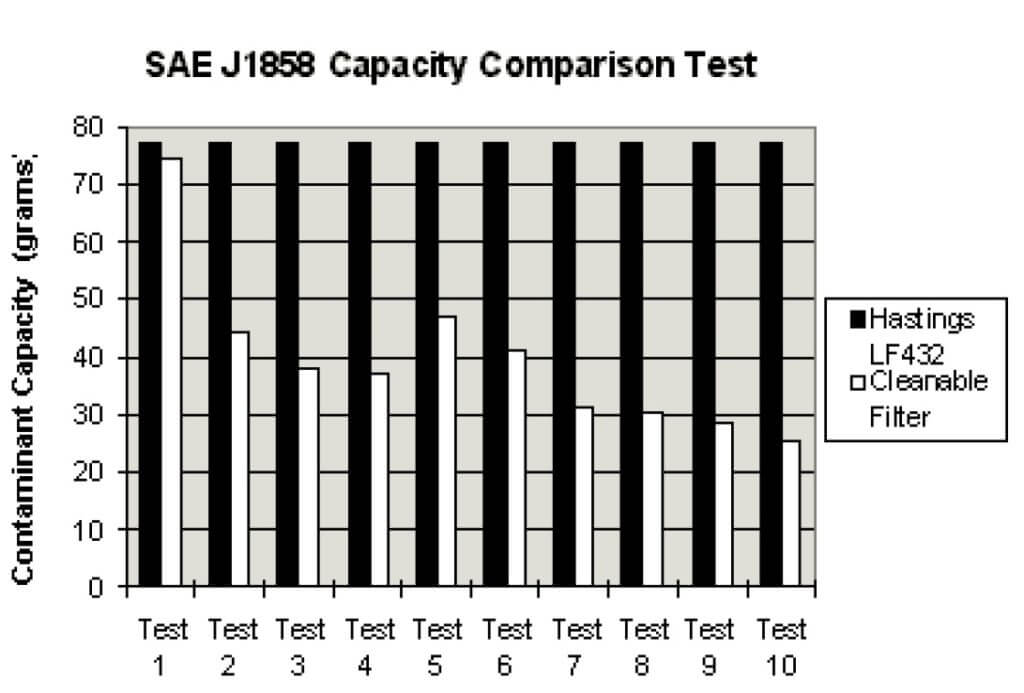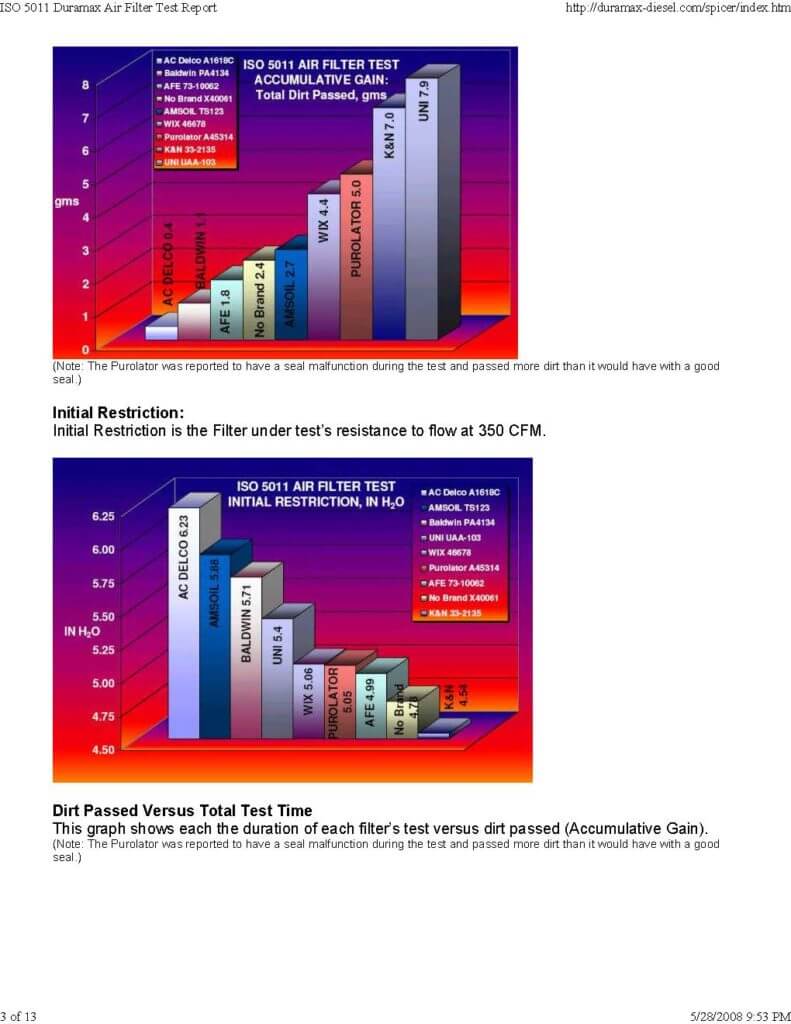Auto Air Filters
How to choose an auto air filter
Auto air filters have come a long way since the first oil bath filters that were filled with fine steel wool soaked in motor oil. Today’s factory air filters are made from cellulose fibers of various sizes and combination filters made with a blend of organic and inorganic fibers. Then there’s the performance air filter category that promises increased airflow, mostly through the use of oiled cotton fibers and increased surface area.
First, a bit of info about air induction systems
Carbureted engines
Air filters in carbureted engines were usually round cellulose devices that mounted directly above the carburetor. The snorkel on carbureted air filter holders often contained a thermal valve to suck heated air from a “stove” assembly surrounding the exhaust manifold. When the engine was started cold the heated air from the exhaust manifold helped vaporize the cold fuel being sprayed into the cold intake manifold. However, as the engine warmed up, the thermal valve changed position suck in underhood air instead.
Fuel-injected engines
Fuel injectors do a much better job of vaporizing the fuel than older carburetors. So carmakers moved the air filter away from the intake manifold and arranged the air duct to draw in outside “cold” air, due to cold air’s higher mass. By drawing in high mass cold air and measuring its mass with a mass airflow sensor (MAF) located directly after the air filter, the engine computer and more accurately meter fuel to obtain the most power and efficiency. But the filter box move wasn’t just for drawing in cold air.
AN OEM filter box on a fuel-injected vehicle is purposely designed to accomplish four things:
1) Create a swirl/vortex airflow pattern inside the filter box that causes particulate matter to drop out of suspension and fall to the bottom of the box, thereby extending the life of the air filter.
2) Reduce inrush air noise through by creating a noise-canceling airflow path.
3) Create laminar airflow across the sensing elements in the MAF sensor
4) Filter out harmful particulate matter while also providing maximum airflow and the lowest pressure drop across the filter.
To accomplish these goals, carmakers have designed pleated/fluted high filtration filters that occupy less underhood space than previous designs. The filters provide low flow restriction, high dust-holding capacity.
Performance cold air intakes eliminate the benefits of the factory cold air intakes
Based on a bogus theory that a larger filter with more surface area creates more airflow, many aftermarket cold air intake manufacturers and DIYers remove the factory air filter box and replace it with an aftermarket system.
The purported benefits of an aftermarket cold are intake are:
More horsepower due to greater airflow
Better gas mileage due to increased airflow efficiency
Lower cost due to a reusable design.
Let’s look at each of those claims.
Do aftermarket cold air intakes provide more horsepower by providing less air restriction and more airflow— Ture or False?
Aftermarket cold air intake filters do provide vastly more surface area. So, in theory, they don’t clog as often as a factory air filter. Plus, they provide less restriction and allow more airflow into the engine. Unfortunately, that doesn’t necessarily translate into a benefit. Here’s why.
Aftermarket cone filters clog faster than factory air filters
First, recall that factory air filter boxes are purposely designed to create a vortex that drops particulate matter out of suspension. Aftermarket cold air filters lack the vortex design, so they actually need the extra surface area because more particulate matter hits the filter surface. So, in dirty environments, they can actually clog faster than a smaller surface area factory filter.
In SAE J1858 filter capacity tests done by Hastings Filter Company, aftermarket oiled filters lost their dirt-holding capacity over repeat washings and re-oiling cycles.
“We recently tested one of the latest market offerings for a reusable engine oil filter. During the first test cycle, the filter demonstrated nearly the same efficiency and capacity of a standard replaceable filter. However, the performance of the filter element during subsequent use cycles fell off dramatically. By the 10th use cycle (as recommended by the manufacturer), the contaminant holding capacity had decreased by 67%. The chart below illustrates the decrease in capacity with the successive uses of the reusable filter compared to the performance offered by a conventional Hastings filter.” — Hastings Engineering Bulletin 98-3

Hastings dirty holding capacity test
Why does an aftermarket performance filter lose filtration ability with successive cleaning and oiling? Because they shed cotton fibers during use and with each wash/oil cycle. Where do the fibers go? May wind up being baked onto the hot wire in the MAF sensor, which throws off your MAF sensor readings. Others get sucked into the engine, where they’re burned. While the remainder gets dislodged into the soapy water and rinse water during a cleaning cycle.
Aftermarket filters provide more airflow, but at the cost of more dirt entering your engine
Many aftermarket reusable air filters are constructed from cotton and synthetic fibers that are sprayed with oil to capture and hold particulate matter. Due to their larger pore size, they do provide more airflow, but they also let in more dirt—the opposite of what you want in an engine air filter. See the PDF below to view Arlen Spicer’s actual test results using ISO 5011 air filter testing protocols.
Aftermarket filters provide can provide more HP, but only at or near redline
The greatest restriction in an air intake system is NOT the filter, it’s the throttle plate. Even with increased airflow, aftermarket performance filters don’t provide a noticeable increase in HP until the throttle plate is fully open when the engine is at or near redline. So the increased HP claims are meaningless unless you’re racing the vehicle at wide-open throttle.
Aftermarket filters don’t increase fuel mileage
Again, the greatest restriction in an air intake system is NOT the filter, it’s the throttle plate. According to the Automotive Aftermarket Suppliers Association (AASA), “modern air filters have more than enough surface area to support airflow during normal driving conditions. Even if airflow through the air filter becomes slightly restricted, the powertrain control module (PCM) will use the mass airflow (MAF) sensor input to match the volume of incoming fuel with the volume of incoming air. So, even while horsepower might be slightly reduced due to restricted airflow, fuel economy and power won’t suffer during normal driving conditions.”
…the popular perception is that increasing air filter capacity will increase an engine’s horsepower and fuel economy. The reality is that increasing the airflow beyond the capacity of the engine’s peak demand will do nothing to enhance performance. In practically all cases, the OE air filtration system is, by far, the most efficient and the least maintenance-intensive system on the market simply because its design matches the engine’s original intake airflow requirements. — Air and Fuel Filter Service Tips knowyourparts.com/technical-articles/air-and-fuel-filter-service-tips/
Reusable aftermarket cone filters don’t really reduce the cost of ownership
When you consider the initial cost of an aftermarket cold air intake assembly, compared to the cost of regular air filter replacements, they don’t reduce the cost of ownership. That’s especially true when you consider that the Hasting’s tests show that a reusable filter’s dirt holding capacity drops by 67% after the 10th washing. Even though performance filter manufacturers claim their filters are “lifetime,” it’s obvious from the testing that you really should replace them rather than suffer decreased filtering capacity.
Typical cost of aftermarket cold air intake system. $291.99 (69-1507TS K&N Performance Air Intake System)
1 replacement filter (after the 10th washing) Approximately $52
Total cost $343
10 cellulose air filters @ $15-ea. $150.
The best air filters are OE or OE compatible filters from major filter manufacturers
Bosch, Denso, Hastings, Mahle, Fram, ACDelco, Mann, Wix, Purolator
©, 2020 Rick Muscoplat
Posted on by Rick Muscoplat

